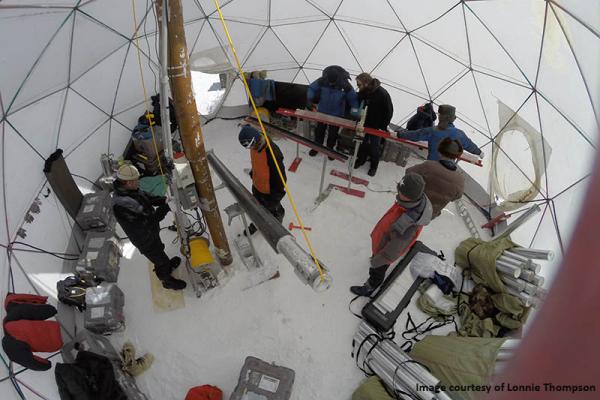Using Isotopic Composition of O2 in Dating a Tibetan Ice Core Record of Holocene/Late Glacial Climate

The study's lead author is Lonnie Thompson, Distinguished University Professor in the School of Earth Sciences and Senior Research Scientist at the Byrd Polar and Climate Research Center at The Ohio State University. Thompson and his colleagues developed a robust chronology of regional climate variability from ice chemistry records, specifically ratios of heavy to light oxygen in the ice, or oxygen isotopes ((δ18Oice), from three ice cores from the Guliya ice cap in the northwestern Tibetan Plateau. To help develop the chronology of the climate record, the scientists used measurements of the isotopes of oxygen in air trapped in bubbles in the ice (δ18Oatm), a technique which has rarely been used on ice cores obtained from outside the polar regions. One of the papers co-authors, Jeff Severinghaus of Scripps Institution of Oceanography, managed to develop corrections to the δ18Oatm data to address issues associated with refrozen melt and micro-organisms respiration, which are complications that are not usually encountered in polar ice cores.
The study, which appears in the recent issue of Proceedings of the National Academy of Sciences, reveals climatic variations in the northwestern Tibetan Plateau over the last 15,000 years. These variations in the Guliya record correspond to those observed in independently dated lake and speleothem records from the Tibetan Plateau and South Asia and confirm that the Guliya ice cap existed before the Holocene. The results also reveal that the Guliya δ18Oice values since the mid-20th century have been the highest in almost 12,000 years, suggesting recent dramatic changes in the climate of this region which is undergoing rapid population growth and agricultural development.
Read more about the study published in PNAS.
The online publication EurekaAlert! also highlighted this study in an article titled Scientists bring back Earth's memory with mountaintop ice.
The image to the right is of a team of scientists in 2015 inside a core drilling dome recovering ice cores from the Guliya ice cap in the Kunlun Mountains.
